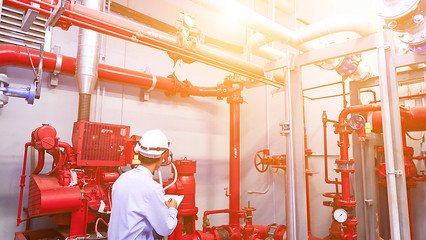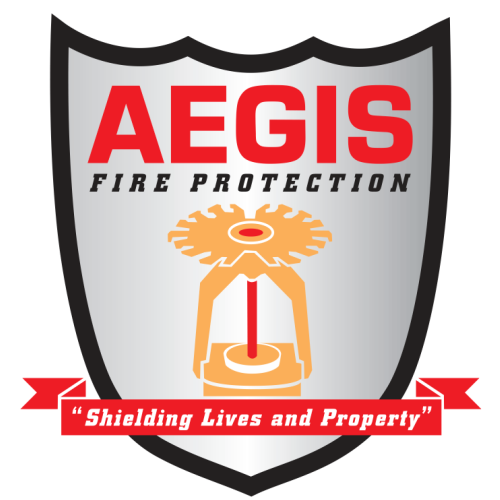Who We Are
Founded in 2007, Aegis Fire Protection LLC is a full-service fire protection company serving the greater KC Metro and Springfield, MO areas. We are specialized in the design, installation, and inspection of both Fire Sprinkler and Fire Alarm Systems—protecting your lives and assets every step of the way.
We respond to service calls 24/7 and work diligently to fit your schedule.
Our NICET Certified design team has over 30 years of in-field experience.
BIM coordination is available.
We specialize in both Fire Sprinkler Systems and Fire Alarm Systems, including:
Wet & Dry Fire Sprinkler Systems
Fire Pumps
Backflow Preventors
Fire Extinguishers
Custom Design Work
Experience
& Reliability
100 years of combined experience in the Fire Protection and Fire Detection industry.
Design Work
Expertise
Our design team has over 30 years of in-field experience. BIM Coordination is available. NICET Certified.
Full Customer
Service Support
We make service calls and work diligently to flexibly fit your schedule.
Testimonials
Accolades
Common Types of Active Fire Protection Systems
There are various types of active fire protection systems that are installed in buildings to help safeguard people and property from fires, including:
Fire sprinkler systems – This common type of fire protection system uses water to fight fires. When a fire is detected, sprinkler systems automatically activate and discharge water through the sprinkler head that is nearest to the fire.
Fire suppression systems – A fire suppression system is installed in areas where water damage could be destructive or where water is not an effective way to suppress a fire. These systems use agents such as gas, chemicals, or foam to extinguish fires.
Fire alarm systems – Fire alarm systems alert building occupants that a fire is occurring so that they can safely evacuate the building. Fire alarms can be manually activated by someone in the building, or they could be triggered automatically when a fire is detected.
Fire detection systems – These systems detect the presence of a fire and activate the fire sprinkler or suppression system. Common types of fire detection include smoke detection, flame detection, and heat detection.
Do You Know The Most Common Causes Of Fire In Your Industry?
The potential source of fire in your commercial environment determines what kind of fire protection will be best for your needs. It is important to be aware of the leading cause so that you can prepare yourself and your employees for an emergency. There is no such thing as being over-prepared in a fire emergency, so it is always in your best interest to be knowledgeable about how to protect your business from fire.
Commercial Kitchens
According to the National Fire Protection Association (NFPA), about 7,400 fires break out in bars and restaurants each year in the US. The commercial kitchen is the most likely place for fires to originate.
Cooking equipment—including deep fryers, ranges, ovens, grills, barbecues, rotisseries, portable warming equipment, and grease hoods—cause 61 percent of all restaurant fires or about 4,500 fires per year. This isn’t too surprising, given the frequency of cooking fires.
Other leading causes of fire in the restaurant industry include:
Electrical and lighting equipment (9 percent)
Heating equipment (9 percent)
Smoking materials (7 percent)
Arson (4 percent)
Aegis Fire Protection offers kitchen fire suppression services to defend against all types of fires in commercial kitchens, no matter their origin. Contact us now to learn more.
Office Buildings
The NFPA states that over 3,300 fires start in office properties across the US each year. As with other industries, cooking equipment is the leading cause of fires in office buildings, causing nearly 1,000 blazes per year, or 29 percent of the annual total in this industry.
Other common causes of fire in office buildings include:
Electrical and lighting equipment (12 percent)
Heating equipment (11 percent)
Arson (10 percent)
Smoking materials (9 percent)
Exposure (4 percent)
Electronic, office, and entertainment equipment (3 percent)
Flammable and combustible materials are the main reason fires spread in office buildings. Once a fire starts, it uses these materials to help the fire grow larger and hotter. Therefore, appropriate storage and proper disposal of such materials is an important part of your fire safety efforts.
Industrial Spaces
Fires in industrial buildings, including factories and manufacturing plants, are some of the costliest, both in terms of property damage and loss of life. The NFPA states that 37,000 industrial fires start annually in the US, resulting in 18 civilian deaths, 279 injuries, and $1 billion in property damage. The most common fire risks in these industrial environments include:
Combustible dust easily catches fire if there’s a spark. If enough dust has accumulated on the factory floor, the flames can spread at an alarming rate.
Flammable liquids and gases can cause an explosion if they come in contact with a heat source.
Welding, torch cutting, and other hot work send sparks and molten material into the air, a common reason for combustible dust or flammable liquid to catch fire.
Electrical wiring that is overloaded or not installed to code can cause a spark, creating an ignition source for combustible dust and flammable liquids.
Heavy machinery can be a fire hazard if moving parts create too much friction and heat.
Mission-Critical Environments
Airports, aircraft hangars, jet engine test facilities, refineries, and other mission-critical environments face increased fire threats due to their open floor areas, high roof decks, and the presence of flammable liquids that serve as an ignition source. The NFPA states that more than 50,000 fires are started per year in the US because a flammable liquid caught fire, many of which occur in mission-critical environments.
Because of their high-risk environments and delicate equipment, mission-critical businesses require clean agent suppression systems. Clean agents work to quickly contain and eliminate the fire source without the use of water so that the equipment sustains minimal damage.

Why Are Fire Alarms So Loud?
If you have ever been to a rock concert, passed by a jackhammer at a construction site, or heard the sonic boom of a fighter jet, you know that exposure to loud sounds can physically hurt your ears. Many people avoid loud settings because excessive noise can lead to hearing problems in the future.
This begs the question—why are fire alarms so loud? And is there anything you can do to protect your ears from the noise?
How Loud Are Fire Alarms?
NFPA 72 outlines the requirements for fire alarm notification appliances, which take two primary forms: audible and visible.
Horns and sirens provide the audible alert, sounding off at 65 to 120 decibels (dB) when standing 10 feet from the device.
Strobe lights provide the visible alert, flashing once per second at 15 to 1,000 candelas, depending on the setting.
There’s no denying that prolonged and repeated exposure to loud noises can damage your hearing. The National Institute on Deafness and Other Communication Disorders (NIDCD) states that 85 dB and higher is the danger zone for hearing loss.
Here are some comparative noise examples to help you understand the loudness of different decibels:
Indoor conversation: 50 dB
Chatter in a restaurant: 60 dB
Vacuum cleaner: 70 dB
Garbage disposal or food blender: 80 to 90 dB
Power lawn mower or motorcycle engine: 100 dB
Thunderclap: 120 dB
Jet take-off from 25 meters away: 150 dB (eardrums may rupture if exposed to this volume without ear protection)
Why Do Fire Alarm Volumes Vary?
Obviously, the goal of a fire alarm is to make sure everyone in the building knows to evacuate the building. That’s why the NFPA requires fire alarm horns and sirens to sound louder than ambient noises.
The specific requirement is 15 dB above the average noise level or 5 dB above the maximum ambient sound, whichever is greater. This means it might be required to program fire alarm horns to 75 dB for a restaurant or office setting, but an industrial facility with loud equipment may need to sound off closer to the maximum 120 dB level to ensure the sound is distinguishable from other ambient noises.
The high-volume requirement for fire alarms accounts for the fact that distance from the horn decreases its perceived volume, and building materials absorb noise, particularly if the doors are closed between rooms. Due to these factors, the decibel level must be high at the source to make certain the sound travels to every corner of the building.
How Can You Protect Your Ears From Loud Fire Alarms?
When you hear the shrill noise of a fire alarm, your first instinct is to cover your ears. This is actually an effective way to protect against hearing loss while you walk calmly toward the exit and make your way out of the building.
More important, however, is to create a fire evacuation plan and hold fire drills regularly. This way, your staff is confident about what steps to take and where to evacuate in case of an emergency. By planning ahead, you can limit confusion and reduce the time you’re exposed to loud volumes.
Finally, if you think the decibel level of your fire alarm is too high, hire a fire protection company to examine your equipment and make a determination. Your technician will make sure the volume is just right for safety and compliance with NFPA 72.









